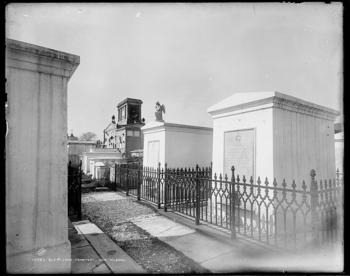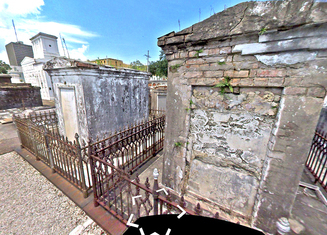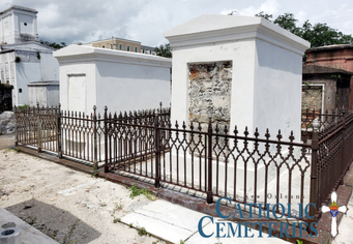
A platform that encourages healthy conversation, spiritual support, growth and fellowship

NOLACatholic Parenting Podcast
A natural progression of our weekly column in the Clarion Herald and blog

The best in Catholic news and inspiration - wherever you are!
Initiative restores abandoned tombs, one by one
-

Pictured above: This late 19th-century image of the Clay (foreground) and Maritche family tombs in St. Louis Cemetery No. 1 reveals their once pristine condition. Scroll down to see the tombs before and after their restoration by New Orleans Catholic Cemeteries. (Photo courtesy of the Library of Congress, Item. No. 2016798495)
Story by Beth Donze, Clarion Herald
Over the last few years, the staff of New Orleans Catholic Cemeteries has made significant strides in restoring tombs in historic cemeteries that were in a state of disrepair and have no known owner.“Our ‘Abandoned Tomb Initiative’ exists for those tombs that no longer have families to care for them,” explained Sherri Peppo, director of New Orleans Catholic Cemeteries. “However, the majority of our tombs do have caretakers, and they do a fantastic job ensuring that their family tomb is properly looked after.”
Since launching in early 2017, the initiative has completed the restoration of 13 tombs, all but two located in St. Louis No. 1 and No. 2 cemeteries. The two other restored tombs are inside St. Joseph Cemetery on Washington Avenue, Peppo said.
“St. Louis No. 1 and 2 are our two oldest cemeteries, so they have the most abandoned tombs in them,” Peppo said, referring to the burial sites established in 1789 and 1823, respectively.
The initiative is made possible through contributions from private and corporate donors, and from tourism monies once generated from entrance fees to St. Louis Cemetery No. 1 (which have dried up since the COVID-19 pandemic was recognized in mid-March).
All tombs identified for overhauls are restored in accordance with the National Park Service guidelines for historic restoration projects, which includes the use of lime-based plaster and limewash.
Depending on the size and condition of the tomb, each restoration takes a few weeks,” said Heather Veneziano, New Orleans Catholic Cemeteries’ director of public engagement and development.
“With lime-based products there’s a drying time involved,” Veneziano explained. “The first step is to clean the tomb and take off any Portland cement – or any other hard-surface materials that are detrimental to the condition of the tomb.”
Multiple coats of lime plaster, while they take longer to apply, “allow the tomb to breathe, and that way it will last a lot longer than if you just go in and use Portland cement and paint it,” Veneziano added. Cast-iron elements, such as railings, are sanded and painted with a durable paint, while tablets are cleaned but left in their original condition, Veneziano said.
French Quarter businessmen
The initiative’s most recent project, nearing completion, involves a pair of side-by-side tombs in St. Louis Cemetery No. 1.
“These are exciting because we were able to find a historic photograph of the tombs from the late 1800s,” said Veneziano, who subsequently learned the following about the tombs’ respective occupants:
• The family tomb of New Orleans-born Jean Baptiste Francois “John” Clay (1805-1864) marks the final resting place of a prosperous free man of color who worked as a stockbroker in the French Quarter at 300 Royal St. Clay married Marie Antoinette Euphemie Moore (1808-1905) on Nov. 17, 1825, in St. Louis Cathedral.
• Directly adjacent to the Clay tomb is the tomb of the Maritche family. The family’s patriarch, Nelson Maritche (c. 1808-1874), lived on Bourbon Street with his wife Emilie and their children. Veneziano’s research revealed that the family operated a grocery store in the French Quarter at 1039 Burgundy St.


The Clay and Maritche family tombs are pictured earlier this year (above, left), before their restoration by New Orleans Catholic Cemeteries, and (above, right) on the home stretch of their historically sensitive restorations. (Photos courtesy of New Orleans Catholic Cemeteries)
Mapping of St. Louis No. 2All donations to the Abandoned Tomb Initiative go directly to the restoration work. The tomb repairs are managed by Joseph Connor, assistant director of operations at New Orleans Catholic Cemeteries.
“We do not resell any of the (restored) tombs,” said Veneziano, who is about to begin a tomb-by-tomb survey of the more than 1,100 tombs in St. Louis No. 2, complete with individual photographs and condition reports.
“With that information, we’ll be able to better prioritize repairs, apply for grants and move forward with more extensive work in that cemetery,” Veneziano said. “The need (to restore abandoned tombs) is so great that it’s going to outlast our grandchildren’s generation, but we have to start somewhere!”
To learn more about the Abandoned Tomb Initiative, visit www.nolacatholiccemeteries.org. Heather Veneziano can be reached at [email protected].




